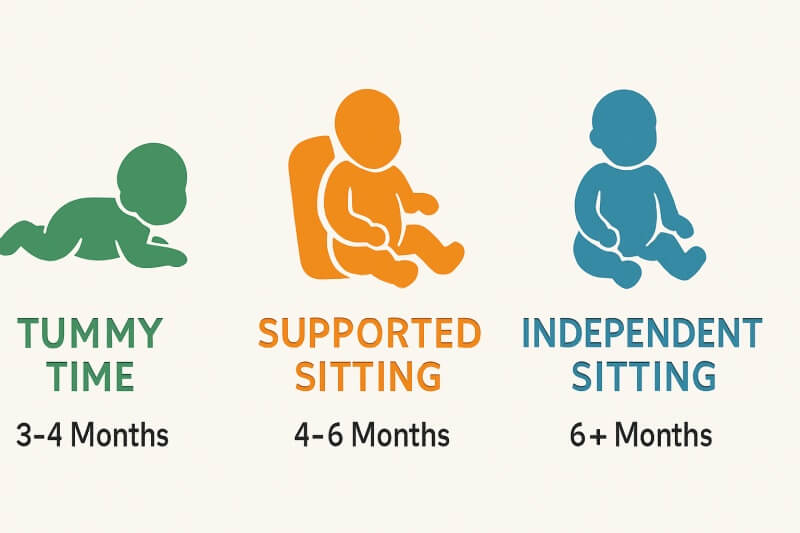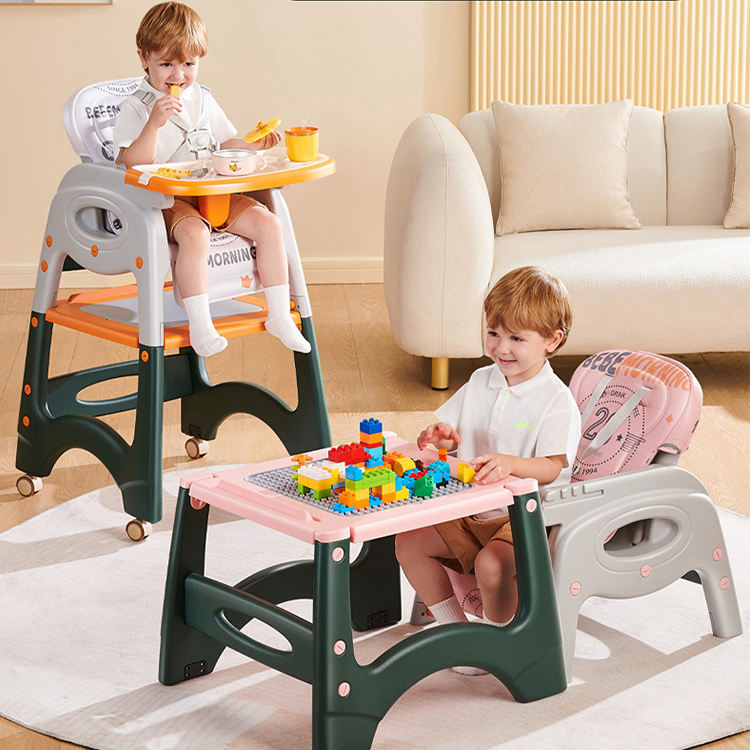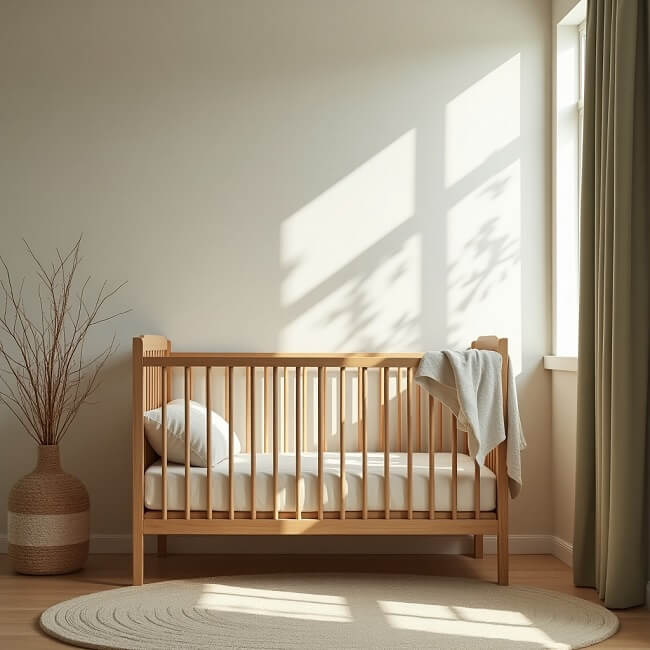The arrival of a high chair often feels like a milestone—a clear sign that solid foods and family mealtimes are just around the corner. But for many new parents, the question is not if but when to start using it safely.
However, experts agree: high chair readiness is about developmental skills, not the calendar. Rushing the process can be more than just messy; it can be dangerous if your baby lacks the core strength needed to sit upright. A baby who is not developmentally ready can easily slump, which puts pressure on their spine and can even affect their airway while eating.
This article is your expert guide to making this transition safely and smoothly.
Understanding Baby’s Developmental Milestones for Sitting

Head and Neck Control
The first, non-negotiable requirement for high chair use is complete and stable head and neck control. This control is developed during “tummy time” and early developmental play, typically around the four-to-six-month mark.
Why is this foundational? When a baby’s head is unstable, they cannot protect their airway. If they slump forward or their head falls back while chewing or swallowing, they are at a greatly increased risk of choking.
Think of the high chair as a vertical platform for feeding; without a stable foundation at the top, the entire process is unsafe. Pediatricians emphasize that until this skill is mastered, high chairs and solid foods must wait.
The Role of Trunk Stability in High Chair Use
After mastering the head, the next crucial step is developing trunk stability—the core strength needed to sit independently. This stability comes from the coordinated work of the abdominal and back muscles.
Many parents mistake “supported sitting” (where a baby is propped up by pillows or a seat insert) for true readiness. However, a high chair demands “unsupported sitting,” meaning the baby must hold their torso upright on their own.
This skill is vital because a slumping torso can compress the lungs and stomach, making digestion harder and interfering with the mechanics of swallowing. A baby with poor trunk stability is also more likely to lean sideways to compensate for weakness, risking a fall or an uncomfortable, unproductive mealtime.
How Baby’s Reflexes Relate to High Chair Use?
Beyond muscle strength, developmental reflexes play an important part in high chair safety. Specifically, the sitting balance reflexes must be present. These are automatic responses that help your baby maintain stability and prevent falling over.
When a baby is pushed slightly off balance, these reflexes trigger the opposite muscles to contract, pulling them back to a vertical position. If these reflexes are not fully matured, a sudden reach for a toy or a slight movement in the chair could cause them to topple forward or sideways. The high chair is often the first place these reflexes are truly tested on a daily basis.
What Are the 3 Signs of High Chair Readiness?
The question of when to start the high chair is really a question of whether your baby has mastered three specific signals. These three signs must be present together to create the safest and most efficient feeding environment. Think of them as a safety lock: if one pin is missing, the mechanism will not work properly.
Sign 1: Sitting Up Unassisted for at Least One Minute
This is the most direct indicator of readiness. “Unassisted” is the key word here. It does not mean sitting in a cushioned baby seat or propped up by a sofa. It means your baby can be placed on a flat, firm surface and maintain a straight posture for a minimum of 60 seconds without using their hands to prop themselves up.
For parents, a great way to test this skill is to observe your baby during playtime. Do they effortlessly transition from lying down to sitting up? When reaching for a toy, do they keep their spine straight, or do they immediately slump?
Sign 2: Doubled Birth Weight
Weight gain is important because it is closely related to the baby’s overall muscle tone and skeletal maturity. By the time a baby has doubled their birth weight (which usually happens around five or six months), their body has grown significantly stronger.
The increased mass requires stronger muscles to support it, particularly the core and back muscles we discussed earlier. While this sign is more about general physical maturation than the ability to sit, it serves as a powerful supporting signal.
This milestone shows the baby’s body is physically ready to handle the vertical gravitational load that sitting in a high chair demands. It also often aligns perfectly with the pediatrician-recommended time to introduce first foods.
Sign 3: The Loss of the Tongue-Thrust Reflex
This third signal is entirely different from strength, but it is critical for feeding safety. The tongue-thrust reflex is a natural, protective mechanism that causes infants to automatically push anything solid placed on their tongue back out of their mouth.
This reflex is designed to protect them from choking on foreign objects and makes it impossible to swallow solid food safely. As babies mature, typically near the six-month mark, this reflex fades, allowing them to move food from the front of the mouth to the back for swallowing.
The loss of this reflex is not just a sign of high chair readiness, but a fundamental sign of readiness for solid foods. If your baby still pushes food out with their tongue, using a high chair for feeding is pointless and frustrating for everyone involved.
What Is the Best Age to Start Using a High Chair?

While we have established that readiness is key, parents still look for a general time frame. Knowing the typical age window can help you prepare.
6 Months: The Safety and Developmental Sweet Spot
For the majority of healthy infants, the six-month mark is the developmental sweet spot. This age aligns almost perfectly with the recommendations from the World Health Organization (WHO) and major pediatric associations to begin complementary foods.
By six months, most babies have achieved all three readiness signals: independent sitting, doubled birth weight, and the faded tongue-thrust reflex. Starting at six months synchronizes feeding mechanics with physical ability.
The Risks of Starting Too Early
If you are considering using the high chair earlier—perhaps at four or five months—it is crucial to understand the risks.
Placing an infant with underdeveloped spinal support in a vertical sitting position can place undue stress on their still-soft cartilage and developing vertebrae.
Furthermore, if the core strength is inadequate, the baby may slump forward. This poor posture is not just uncomfortable; it makes the act of self-feeding or being spoon-fed less effective and potentially more hazardous.
When is it Time to STOP Using the High Chair?
Most children transition out of a traditional high chair between 18 months and 3 years old. The key signals to look for are behavioral and physical:
- The baby regularly attempts to climb in or out while the harness is undone or even secured, posing a serious fall risk
- The child’s weight exceeds the manufacturer’s specified limit (typically 40 to 50 pounds)
- The child consistently resists being strapped in and is ready to sit at the family table, usually with the aid of a booster seat or a convertible high chair that transforms into a toddler chair.
How to Introduce Your Baby to the High Chair Smoothly?

Once your baby is developmentally ready, the introduction process needs patience and strategy. A high chair can be a strange, new environment for an infant who has only experienced the close comfort of being held or lying down.
Create a Positive Association: It’s Not Just for Food
Start by having them sit for just five to ten minutes at a time. Put a favorite suction-cup toy or a board book on the tray for a quick, fun activity. This helps to create a positive association with the furniture.
Gradually increase the time they spend there, making sure to supervise them constantly. This positive habit formation minimizes resistance and confusion when you introduce actual meals.
Mastering the ’90-90-90′ Rule for Optimal Feeding Posture
The ’90-90-90′ rule is the gold standard for high chair posture, a vital part of safe, productive feeding. It means three joints should all be at a 90-degree angle:
- Hips at 90 degrees (seated firmly against the back of the chair),
- Knees at 90 degrees
- Ankles at 90 degrees (feet resting flat on a solid footrest).
The footrest is non-negotiable. Without a solid place to push against, a baby’s core muscles cannot fully engage, which leads to slumping or rocking. Proper posture is not just for comfort; it directly impacts oral motor skills.
Troubleshooting Common High Chair Refusals
What if your baby starts to resist the chair? High chair refusals are common and usually signal an underlying issue that needs adjustment.
First, check the fit and comfort: Is the harness digging in? Is the seat insert too tight?
Second, review the timing: Is the baby overly tired or hungry? A meltdown is likely if you try to strap them in at a known fussy time.
Third, change the location: Try moving the high chair closer to the family dining table. Babies have a strong drive to participate. Including them in the family meal environment can instantly reduce resistance
High Chair Safety Checklist: 5 Rules You Must Follow
1. Always Use the Harness, Every Time. While a tray might seem secure, only the harness prevents a determined baby from climbing out or slipping down. Opt for a 5-point harness high chair, which includes straps over the shoulders, waist, and between the legs.
2. Never Leave Your Baby Unattended. Accidents happen fast—often in less time than it takes to grab a dropped spoon. If you must walk away, even for a few seconds to answer the door or retrieve a forgotten item, take your baby out of the high chair and bring them with you.
3. Eliminate “Push-Off” Points. Babies are surprisingly strong and resourceful. Never place the high chair close to a counter, table, or wall. They can use these surfaces to push against, potentially tipping the entire chair over and leading to a serious fall.
4. Check All Locks and Mechanisms. If you have a foldable chair or a model with wheels, always double-check that the locking mechanisms are securely engaged before placing your baby inside. For chairs with removable trays, ensure the tray locks firmly into place and cannot be easily dislodged.
5. Adhere to Weight and Height Limits. Once your child exceeds the chair’s recommended maximum weight, or if they are tall enough to brace their feet against a solid object and attempt to stand up, it’s time to transition them to a booster seat or toddler chair.
Choosing the Right High Chair for Your Baby’s Stage
The high chair market offers three main categories.
Standard high chairs are fixed-frame units, often featuring large trays and limited adjustability. They serve their purpose well but offer no life beyond the toddler stage.
Booster seats strap onto an existing dining chair, saving space and making travel easier, but they often lack the postural support younger babies need.
The third type, the convertible high chair, offers the most long-term value. These chairs are specifically designed to transform from an infant high chair to a toddler booster, and sometimes even into a youth chair or desk chair, growing with your child from six months to five years and beyond.
| Feature | Standard High Chair | Booster Seat | Convertible High Chair |
| Lifespan | Short-term (6 months to 3 years) | Mid-term (1 to 5 years old) | Long-term (6 months to adult) |
| Footprint | Large, fixed | Small, easy to store | Moderate, multipurpose |
| Price Range | Low to medium | Low | Medium to high |
| Postural Support | Good | Variable, depends on model | Excellent, often adjustable |
When investing in a high chair, look beyond the basic functionality. Seek models with adjustable height (to fit your dining table) and, most importantly, an adjustable footrest to achieve the essential ’90-90-90′ posture.
Secondly, easy cleaning saves parents significant time and effort. High-quality designs eliminate crevices and fabric overlaps where food can hide and grow bacteria. Look for features like machine-washable cushion liners, smooth, seamless design, and food-grade plastic trays that wipe down quickly.
FAQs About High Chairs
Q: Can I use a high chair for my newborn?
A: It is not recommended for newborns as they do not have sufficient head and neck control. It is best to wait until your baby has gained enough strength and stability before introducing a high chair.
Q: Are wooden high chairs safer than plastic ones?
A: The safety depends on its design and construction rather than the material. Both wooden and plastic high chairs can be safe if they meet the required safety standards and guidelines.
Q: Can I use a high chair without the tray?
A: The tray provides a convenient surface for feeding and playing. While it is possible to use a high chair without the tray, it may limit the functionality and convenience of the chair.
Q: When should I stop using a high chair?
A: The age at which a child no longer needs a high chair varies. Once your child can comfortably sit at the table and reach the table surface without assistance, you can consider transitioning to a regular chair.
Q: Are there any alternatives to traditional high chairs?
A: Yes, there are alternative seating options available for babies and toddlers, such as floor seats, baby seats, or baby chairs that provide support and stability for sitting. These options may be suitable for families with limited space or who prefer a more minimalist approach to seating.
Conclusion
The decision of when to use a high chair boils down to a single, critical rule: readiness, not age. Wait until your baby can sit up unassisted, has doubled their birth weight, and has lost the tongue-thrust reflex.
Remember, the investment you make in a high-quality high chair is an investment in successful mealtimes and lasting posture. As you shop, look beyond temporary fixes and favor products like convertible high chairs that offer longevity, support the ’90-90-90′ rule, and reflect the highest safety standards.
Recommended Related Articles:













